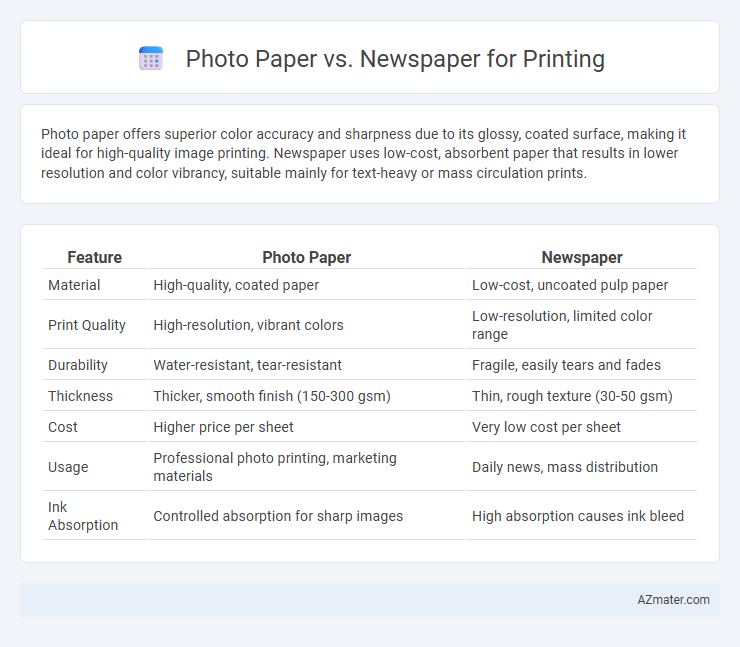Photo paper offers superior color accuracy and sharpness due to its glossy, coated surface, making it ideal for high-quality image printing. Newspaper uses low-cost, absorbent paper that results in lower resolution and color vibrancy, suitable mainly for text-heavy or mass circulation prints.
Table of Comparison
| Feature | Photo Paper | Newspaper |
|---|---|---|
| Material | High-quality, coated paper | Low-cost, uncoated pulp paper |
| Print Quality | High-resolution, vibrant colors | Low-resolution, limited color range |
| Durability | Water-resistant, tear-resistant | Fragile, easily tears and fades |
| Thickness | Thicker, smooth finish (150-300 gsm) | Thin, rough texture (30-50 gsm) |
| Cost | Higher price per sheet | Very low cost per sheet |
| Usage | Professional photo printing, marketing materials | Daily news, mass distribution |
| Ink Absorption | Controlled absorption for sharp images | High absorption causes ink bleed |
Introduction to Print Media Choices
Photo paper offers vibrant colors and high resolution ideal for professional-quality images, whereas newspaper paper is cost-effective and suited for mass distribution of text-heavy content. Print media choices depend on the purpose, with photo paper selected for durability and visual impact, while newspapers prioritize affordability and rapid production. Understanding these materials helps optimize print results based on audience and budget requirements.
Overview of Photo Paper and Newspaper Paper
Photo paper is a high-gloss or matte coated material specifically designed for producing sharp, vibrant images with excellent color accuracy and durability, making it ideal for professional photo printing and high-quality photo reproductions. Newspaper paper, on the other hand, is a low-cost, uncoated, lightweight paper made from recycled fibers optimized for fast ink absorption and mass printing, which results in lower image quality and faster degradation. The choice between photo paper and newspaper paper directly affects print resolution, color vibrancy, and longevity, with photo paper providing superior output for photographic content.
Print Quality: Photo Paper vs Newspaper
Photo paper offers significantly higher print quality compared to newspaper, featuring a smooth, coated surface that enhances color vibrancy and sharpness. Newspapers use low-quality, porous paper that absorbs ink quickly, resulting in dull colors and lower image resolution. For professional or vibrant prints, photo paper ensures precise detail and rich color depth, whereas newspaper is suitable only for basic text or mass distribution prints.
Color Reproduction and Vibrancy
Photo paper delivers superior color reproduction and vibrancy compared to newspaper, due to its smooth, coated surface that absorbs ink evenly and enhances sharpness and saturation. Newspaper uses low-quality, porous fibers that cause ink to bleed and dull colors, resulting in muted images with less detail and contrast. Professional prints requiring vivid, accurate colors consistently favor photo paper for its rich, vibrant output.
Texture and Paper Finish Differences
Photo paper features a glossy or matte finish that enhances color vibrancy and sharpness, making images appear crisp and vivid, while newspaper uses a rough, porous texture with a matte finish that absorbs ink quickly but produces lower image quality. The smooth surface of photo paper reduces ink bleed and smudging, ideal for high-resolution photo prints, whereas newspaper's coarse texture causes ink to spread, resulting in less detailed and muted visuals. Differences in fiber content and coating between photo paper and newspaper contribute to their distinct tactile feel and print quality outcomes.
Durability and Longevity Comparison
Photo paper offers superior durability and longevity compared to newspaper, featuring a glossy, coated surface that resists fading, moisture, and tearing. Newspapers are printed on inexpensive, low-quality newsprint that quickly deteriorates under light exposure, moisture, and handling. Consequently, photo paper is ideal for preserving images and documents over time, while newspapers serve primarily for short-term information dissemination.
Cost Considerations for Printing
Photo paper typically incurs higher costs due to its specialized coating and superior quality, making it ideal for vibrant, high-resolution prints. Newspaper printing utilizes lower-cost, absorbent paper designed for fast, large-volume production, significantly reducing expenses. For budget-sensitive projects, choosing newspaper paper minimizes material costs but may compromise print clarity and color accuracy compared to photo paper.
Environmental Impact and Sustainability
Photo paper generally has a higher environmental impact due to its plastic coatings and chemical treatments, which complicate recycling and increase landfill waste. Newspaper, typically made from recycled paper and printed with soy-based inks, offers a more sustainable option as it is biodegradable and easier to recycle. Choosing newspaper for printing reduces resource consumption and supports circular economy efforts by promoting paper reuse and minimizing pollution.
Best Uses for Photo Paper and Newspaper
Photo paper is ideal for printing high-quality images, offering vibrant colors and sharp details, making it perfect for photo prints, marketing materials, and brochures where visual impact is crucial. Newspaper paper is best suited for mass distribution of text-heavy content like daily news, advertisements, and event promotions due to its low cost and quick printability. Choosing photo paper enhances durability and appearance, while newspaper paper excels in affordability and speed for bulk printing.
Choosing the Right Paper for Your Printing Needs
Photo paper offers high-quality, vibrant color reproduction and sharp detail, ideal for printing photographs and professional images. Newspaper paper is inexpensive, lightweight, and suitable for bulk printing of text-heavy content like newspapers or flyers where cost efficiency is key. Choosing the right paper depends on the desired print quality, durability, and budget, with photo paper enhancing visual appeal and newspaper paper maximizing cost-effectiveness.

Infographic: Photo paper vs Newspaper for Printing
 azmater.com
azmater.com